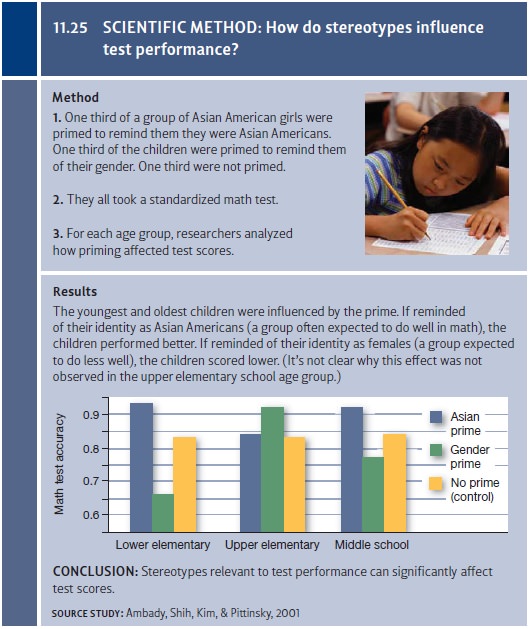Chapter: Psychology: Intelligence
Group Differences in IQ: Stereo Type Threat
STEREO
TYPE THREAT
In
the previous section, we asked whether blacks’ and whites’ IQ scores would be
the same if we could match their environments. If the answer is yes, then this
obviously points toward an environmental explanation of the race difference.
But to tackle this question in a thorough way, it may not be enough to match
factors like parental educa-tion, income, and occupational level. Even if we
succeed in matching for these aspects of life, black and white children still
grow up in different environments. This is because, after all, black children
grow up knowing they are black and knowing a lot about what life paths are
easily open to them and what life paths are likely. White children
corre-spondingly grow up knowing they are white, and they too have a sense of what
life paths are open or likely. Moreover, each group, because of the color of
their skin, is treated differently by the people in their social environment.
In these ways, their envi-ronments and experiences are not matched—even if the
parents have similar jobs and similar income levels, and even if the children
have similar educational experiences.
Do
these social experiences matter for intelligence scores? As one indication that
they do, consider studies of stereotype
threat, a term used to describe the negative impact that social
stereotypes, once activated, can have on task performance. Here’s an example:
Imagine an African American is taking an intelligence test. She might well
become anxious because she believes this is a test on which she is expected to
do poorly. This anxiety might then be compounded by the thought that her poor
performance will only serve to confirm others’ prejudices. These feelings, of
course, could then easily erode performance by making it more difficult for her
to pay atten-tion and do her best work. Moreover, given the discouraging
thought that poor performance is inevitable, she might well decide not to
expend enormous effort—if she’s likely to do poorly, why struggle against the
tide?
Evidence
for these effects comes from various studies, including some in which two
groups of African Americans are given exactly the same test. One group is told,
at the start, that the test is designed to assess their intelligence; the other
group is led to believe that the test is simply composed of challenges and is
not designed to assess them in any way. The first group, for which the
instructions trigger stereotype threat, does markedly worse (C. Steele, 1998;
C. Steele & Aronson, 1995).
Related
results have been shown in many other circumstances and have been demon-strated
with children as well as adults. Similar data have also been reported for
groups other than African Americans, and in fact stereotype threat is plainly
relevant to our pre-vious discussion of comparisons between men and women
(Blascovich, Spencer, Quinn,Steele, 2001; Cheryan & Bodenhausen, 2000). For example (and as we mentioned
earlier), merely reminding test takers of their gender just before they take a
math test seems to encourage women to think about the stereotype that women
cannot do math, and this seems to undermine their test performance. This is
because thoughts about the stereotype increase the women’s anxiety about the
test, cut into the likelihood that they’ll work as hard as they can, and make
it less likely that they’ll persevere if the test grows frustrating (Ambady,
Shih, Kim, & Pittinsky, 2001, Figure 11.25). A different study had students
read an essay that argued that gender differences in math performance have
genetic causes; women who read this essay then performed more poorly on a math
test than did women who read essays on other topics (Dar-Nimrod & Heine,
2006). Presumably, the essay on genetic causes was demoralizing to the women
and made them more vulnerable to stereotype threat—and therefore undermined
their test performance.

Conversely,
some interventions can improve performance, presumably by dimin-ishing the
anxiety and low self-expectations associated with stereotype threat. In one
study, middle-school students were asked to write brief essays—just a few
sentences—about things they valued. The participants were given a list of
possible values to choose from: “athletic ability, being good at art, being
smart, creativity” and so on (G. Cohen, Garcia, Apfel, & Master, 2006;
Cohen, Garcia, Purdie-Vaughns, Apfel, & Brzustoski, 2009). This brief
exercise was then repeated periodically during the school year; and this was
enough to shift the students’ perspective, getting them to focus on things they
valued rather than school-based anxieties. In fact, the brief intervention
improved the school grades of African American seventh-graders by a striking
40%, markedly reducing the difference between white students’ and black
students’ grades. Remarkably, effects of the intervention were still detectable
in a follow-up study with the same students, two years later.
These results draw our attention back to our earlier comments about what intelligence is—or, more broadly, what it is that “intellectual tasks” require. One requirement, of course, is a set of cognitive skills and capacities (e.g., mental speed, or working memory). A different requirement is the proper attitude toward testing—and the wrong attitude (anxiety about failing, fear of confirming other’s negative expectations) can plainly undermine performance. This is why performance levels can be changed merely by priming people to think of themselves as members of a certain group—whether that group is women, Asians, or African Americans. In this way, social pressures and prejudice can powerfully shape each person’s performance—and can, in particular, contribute to the differences between IQ scores for whites and blacks.
Related Topics